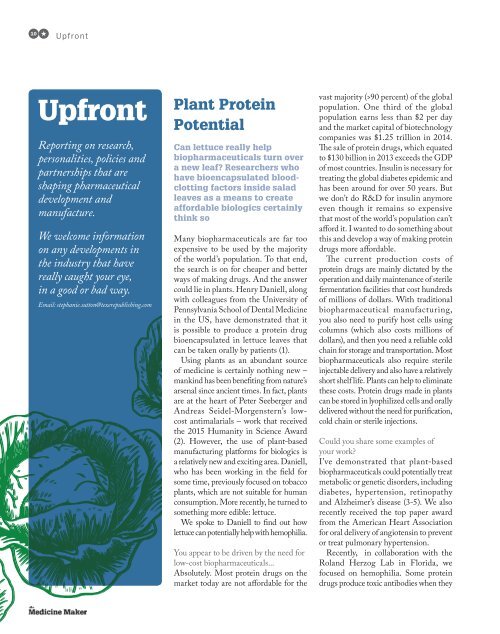Sparks of Inhalation Innovation
TMM_1015
TMM_1015
You also want an ePaper? Increase the reach of your titles
YUMPU automatically turns print PDFs into web optimized ePapers that Google loves.
10<br />
Upfront<br />
Upfront<br />
Reporting on research,<br />
personalities, policies and<br />
partnerships that are<br />
shaping pharmaceutical<br />
development and<br />
manufacture.<br />
We welcome information<br />
on any developments in<br />
the industry that have<br />
really caught your eye,<br />
in a good or bad way.<br />
Email: stephanie.sutton@texerepublishing.com<br />
Plant Protein<br />
Potential<br />
Can lettuce really help<br />
biopharmaceuticals turn over<br />
a new leaf? Researchers who<br />
have bioencapsulated bloodclotting<br />
factors inside salad<br />
leaves as a means to create<br />
affordable biologics certainly<br />
think so<br />
Many biopharmaceuticals are far too<br />
expensive to be used by the majority<br />
<strong>of</strong> the world’s population. To that end,<br />
the search is on for cheaper and better<br />
ways <strong>of</strong> making drugs. And the answer<br />
could lie in plants. Henry Daniell, along<br />
with colleagues from the University <strong>of</strong><br />
Pennsylvania School <strong>of</strong> Dental Medicine<br />
in the US, have demonstrated that it<br />
is possible to produce a protein drug<br />
bioencapsulated in lettuce leaves that<br />
can be taken orally by patients (1).<br />
Using plants as an abundant source<br />
<strong>of</strong> medicine is certainly nothing new –<br />
mankind has been benefiting from nature’s<br />
arsenal since ancient times. In fact, plants<br />
are at the heart <strong>of</strong> Peter Seeberger and<br />
Andreas Seidel-Morgenstern’s lowcost<br />
antimalarials – work that received<br />
the 2015 Humanity in Science Award<br />
(2). However, the use <strong>of</strong> plant-based<br />
manufacturing platforms for biologics is<br />
a relatively new and exciting area. Daniell,<br />
who has been working in the field for<br />
some time, previously focused on tobacco<br />
plants, which are not suitable for human<br />
consumption. More recently, he turned to<br />
something more edible: lettuce.<br />
We spoke to Daniell to find out how<br />
lettuce can potentially help with hemophilia.<br />
You appear to be driven by the need for<br />
low-cost biopharmaceuticals...<br />
Absolutely. Most protein drugs on the<br />
market today are not affordable for the<br />
vast majority (>90 percent) <strong>of</strong> the global<br />
population. One third <strong>of</strong> the global<br />
population earns less than $2 per day<br />
and the market capital <strong>of</strong> biotechnology<br />
companies was $1.25 trillion in 2014.<br />
The sale <strong>of</strong> protein drugs, which equated<br />
to $130 billion in 2013 exceeds the GDP<br />
<strong>of</strong> most countries. Insulin is necessary for<br />
treating the global diabetes epidemic and<br />
has been around for over 50 years. But<br />
we don’t do R&D for insulin anymore<br />
even though it remains so expensive<br />
that most <strong>of</strong> the world’s population can’t<br />
afford it. I wanted to do something about<br />
this and develop a way <strong>of</strong> making protein<br />
drugs more affordable.<br />
The current production costs <strong>of</strong><br />
protein drugs are mainly dictated by the<br />
operation and daily maintenance <strong>of</strong> sterile<br />
fermentation facilities that cost hundreds<br />
<strong>of</strong> millions <strong>of</strong> dollars. With traditional<br />
biopharmaceutical manufacturing,<br />
you also need to purify host cells using<br />
columns (which also costs millions <strong>of</strong><br />
dollars), and then you need a reliable cold<br />
chain for storage and transportation. Most<br />
biopharmaceuticals also require sterile<br />
injectable delivery and also have a relatively<br />
short shelf life. Plants can help to eliminate<br />
these costs. Protein drugs made in plants<br />
can be stored in lyophilized cells and orally<br />
delivered without the need for purification,<br />
cold chain or sterile injections.<br />
Could you share some examples <strong>of</strong><br />
your work?<br />
I’ve demonstrated that plant-based<br />
biopharmaceuticals could potentially treat<br />
metabolic or genetic disorders, including<br />
diabetes, hypertension, retinopathy<br />
and Alzheimer’s disease (3-5). We also<br />
recently received the top paper award<br />
from the American Heart Association<br />
for oral delivery <strong>of</strong> angiotensin to prevent<br />
or treat pulmonary hypertension.<br />
Recently, in collaboration with the<br />
Roland Herzog Lab in Florida, we<br />
focused on hemophilia. Some protein<br />
drugs produce toxic antibodies when they


